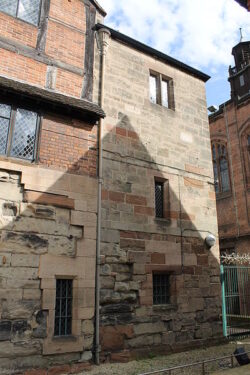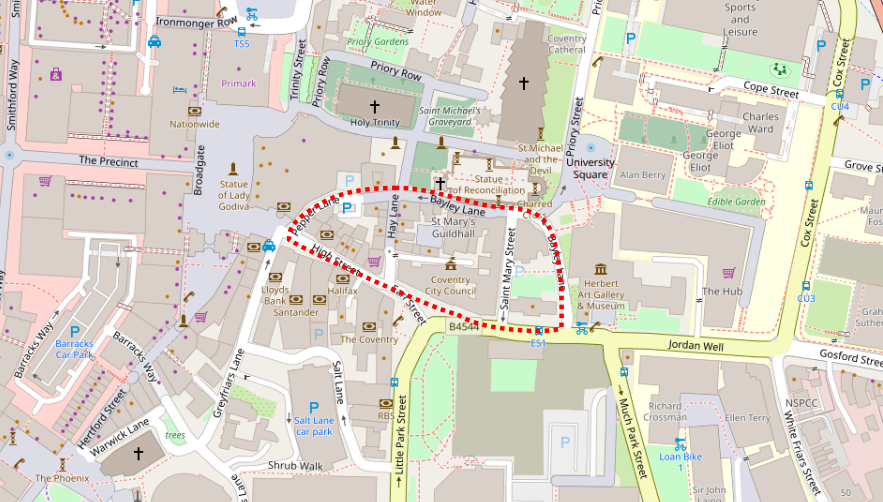
Three castles were built during the medieval period in the city Coventry: Coventry Castle, and two siege castles. Coventry Castle was constructed around 1100, and played a prominent role in the civil war of the 1140s. It fell into disuse by the early-13th century, and the site was built over. One temporary siege castle was constructed at Coventry Priory in 1143, and another nearby in 1146. No remains of any of these fortifications now exists above ground, although Caesar’s Tower, part of St Mary’s Hall, may have been constructed on parts of Coventry Castle’s foundations.
History

After the Norman invasion of 1066, Coventry was a modest sized town, dominated by its two major landowners, the cathedral and the Earl of Chester. Coventry Castle was built by Hugh d’Avranches, the second earl, probably around 1100, although it may have been constructed as early as the 1080s. The castle was built on the southern side of the city, with a large gate – later termed “Broadgate” – on the west side of the castle, and an inner and outer bailey stretching downhill to the east. It appears to have been protected by deep ditches.
By the 1140s, the castle was held by Ranulf de Gernon, the fourth Earl of Chester. England had descended into the civil war known as the Anarchy, and Ranulf allied himself with the Empress Matilda against King Stephen, using his castle in Coventry as one of his bases. By 1142, however, Ranulf and Stephen had been reconciled.
In 1143, one of Stephen’s supporters, Robert Marmion, placed Coventry Castle under siege, claiming – probably falsely – that Ranulf had agreed to give him the city. Robert built his own, temporary siege castle at the Priory, which was then still under construction. Robert expelled the monks and dug a 7.5 m (24.5 ft) wide ditch around the site, creating a form of ringwork castle. Robert subsequently fell into a defensive ditch, injuring his leg and was then killed by one of Ranulf’s men.
In 1146, Ranulf and Stephen’s relationship deteriorated again, and the King detained him until he handed over possession of his castles. Coventry was one of those that Ranulf passed over into royal control. Once freed, Ranulf set about regaining his properties and besieged the royal forces holding Coventry Castle, building another siege castle nearby. Stephen intervened and after the battle forced Ranulf to retreat; the King then demolished the siege castle.
Coventry Castle continued in royal control until Hugh Kevlioc, Ranulf’s son, inherited the earldom in 1162. A decade later, however, Hugh joined in the revolt against Henry II between 1173 and 1174. Royalist forces besieged and took the castle, probably with the assistance of trebuchet siege engines, and after the revolt was over, Hugh’s lands were seized. They were returned to him in 1179, and his son, Ranulf Blundeville, inherited them in turn.
After Ranulf died without heirs in 1235, the earldom and the castle passed back to the Crown, being given to Prince Edward in 1254. Soon after this, Coventry Castle was abandoned– the earls of Chester preferring to use nearby Cheylesmore Manor instead – and indeed may already have fallen into disuse from the 1170s onwards. The castle baileys were let out and eventually built over.
Some parts of the castle survived in use for many years. The bakehouse, called the “castelbachous” in documents, was still used in 1410. The castle prison was also maintained, and the castle’s chapel may have become the Church of St Michael. Caesar’s Tower, now part of St Mary’s Hall, was probably built on part of the castle’s foundations – the current structure is largely a post-war reconstruction, however.
In the 21st century, no remains of the castle survives above ground. Archaeological excavations in 1988 uncovered a deep ditch, which may have been part of the castle defences, or alternatively have been a local quarry.
Bibliography
- Creighton, Oliver and Robert Higham. (2004) Medieval Town Walls: An Archaeology and Social History of Urban Defence. Tempus: Stroud, UK.
- McGrory, David. (2019) Coventry’s Military Heritage. Amberley Publishing.
- Monkton, Linda and Richard K. Morris (eds) (2011) Coventry: Medieval Art, Architecture and Archaeology in the City and its Vicinity. Routledge: London, UK.
- Turner, Hilary T. (1970) Town Defences in England and Wales. John Baker: London, UK.
Attribution
The text of this page is licensed under under CC BY-NC 2.0.
Images on this page include those drawn from the Wikimedia website, and are attributed and licensed as follows: “Caesar’s Tower“, author Rockdrum, released under CC BY-SA 3.0. The plan of the Coventry city centre, which is based on an underlying map copyright OpenStreetMap contributors, and released under CC BY-SA 2.0.
